Pirates vs. Police on the streets of Lima
Youth in Peru take a page from Nepalese rebellion as the pirate flag from "One Piece" flies in pitched street battles against state forces
Ongoing protests in Peru over a range of issues culminated in Lima on Saturday, as thousands of youth protesters clashed with police near the seat of government. Among the many signs with slogans and demands — such as the resignation of President Dina Boluarte — another symbol was also omnipresent: the pirate flag from the manga-turned-Netflix-series “One Piece.”
Protesters in Peru, inspired by similar movements in Indonesia and Nepal, have adopted both imagery from Nepalese youth protests, such as the modified Jolly Rogers, and also tactics.
The youth movement, calling itself “Generation Z” in another nod to the successful Nepalese movement, marched on Congress as part of what they billed the “Day of Peruvian Awakening.”
And dear reader, if you have been following our work here at Pirate Wire Services for any amount of time, you are probably aware that all of us who write here made our names as street journos. Our ongoing frustration with corporate coverage of social movements and protests was one of the main reasons we launched PWS years ago.
So perhaps you can imagine our reaction as thousands of students carrying a pirate flag broke through the police cordon after being clearly attacked first with rubber bullets, pellets, flash bangs, and tear-gas.
Shouting “murderers!”, protesters resist police in downtown Lima: video shot by Jonathan Hurtado in Lima
The Jolly Rogers, the ultimate symbol of freedom, rebellion, and resistance, held high in a cloud of smoke and chaos as thousands of young Peruvians demanded an end to corruption, severe democratic backsliding, censorship of the press, and the resignation of a president with an approval rating hovering around 3%.
Our collective response in the PWS chat group was along the lines of We are so fucking back.
The march began in Plaza San Martín, where hundreds of police officers surrounded the area where a hundred people were waiting to join dozens of other marches in the city.
Police attacked the group, preventing more protesters from entering and scattering them throughout other parts of the city center.
This led to the first clashes between security forces and protesters as disparate (and desperate) youth collectives regrouped and eventually concentrated their efforts inside the plaza as they attempted to advance toward the Government Palace and Congress.
Once the police cordon was broken, the protest moved towards Abancay Avenue, where small fires were set to street furniture and tear gas was fired by the police as running skirmishes continued into early evening.
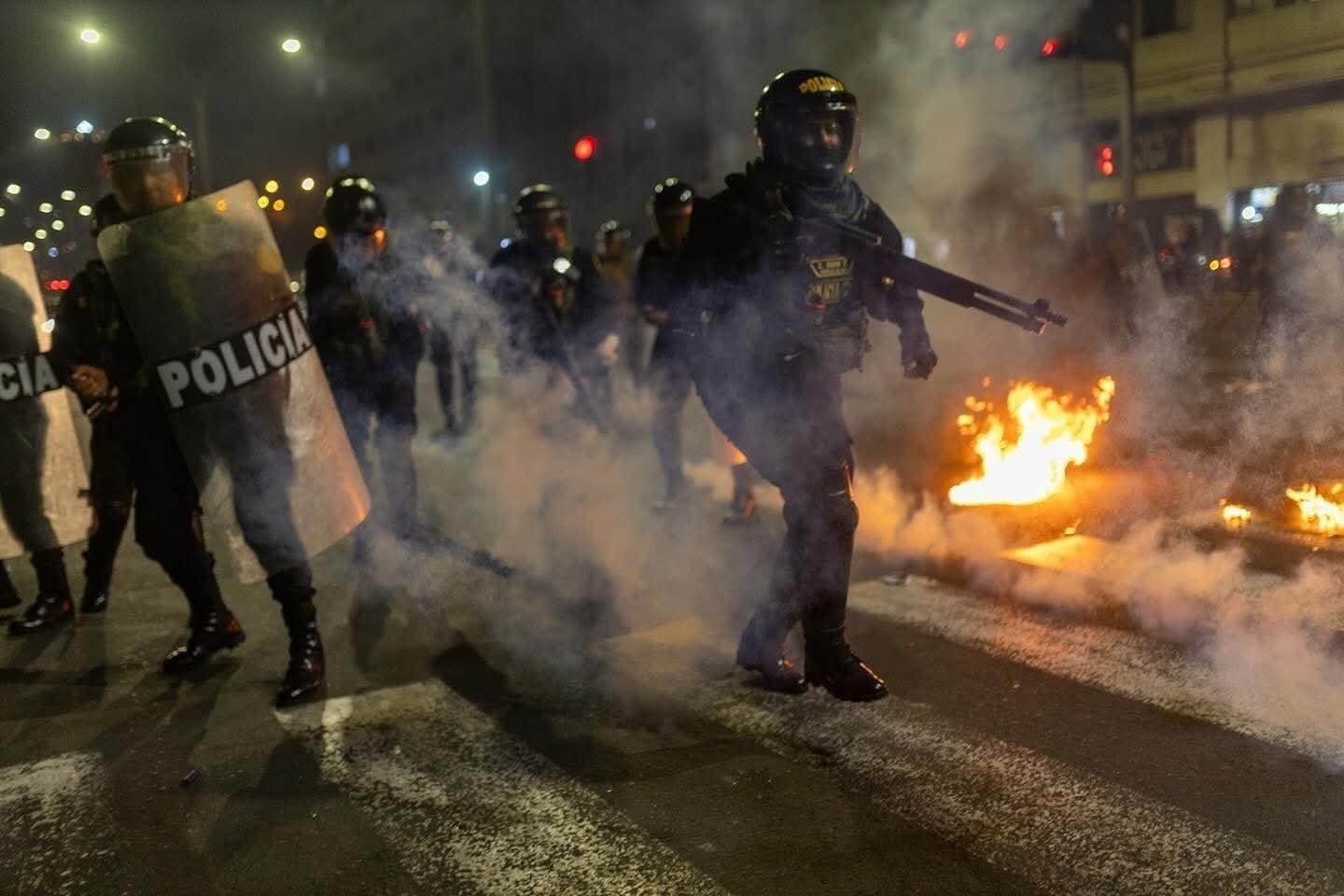
A reporter and a cameraman from the media outlet Exitosa reported live that they were shot several times with pellets by officers while reporting on the protest.
Protester demands were varied, but among them:
respect for the right to protest and justice for 18 victims killed by police in January 2023 demonstrations in Juliaca, as well as 49 more killed as part of national protests in 2022 and 2023
Profound reforms to the pension system
Criticism of a recent law that radically restricts journalism and free speech in the country,
effective actions to combat crime
And the removal of President Dina Boluarte, whom they accuse of aggravating the political crisis.
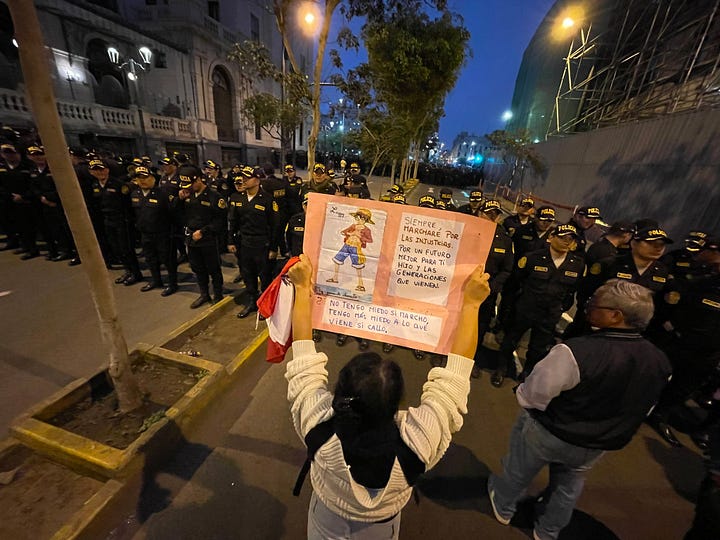
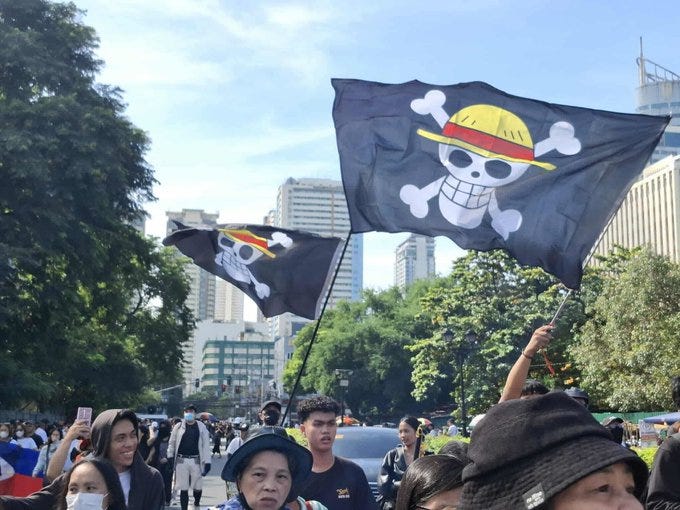


The pirate flag from “One Piece” has appeared recently at youth protests in Indonesia, Japan, the Philippines, South Korea, Nepal, and now Peru. Can we call it a global pirate revolution? Not yet, but it does speak to the resonance of the story of a young man from a humble background finding common cause among his peers to represent all the best ideas and romantic notions of high seas piracy.
The Jolly Rogers was invented to strike fear into the heart of states, and now it is being utilized across the world, albeit with a cartoonish spin, to demand that governments do what they are in theory created to do: bow to the will of the people.
The Jolly Rogers, a thousand variations on black flags that would later be recorded most famously as the skull and crossbones, was flown immediately before battle by pirates to instill terror in the vessels of States with whom they battled.
It was meant to inspire fear, yes, but also convey the idea that pirates were “already dead men”, living on borrowed time. The rejection of flying the colors of a nation-state was also a powerful message of freedom and liberty to all who lived their lives on the high seas.
It was the ultimate message of rebellion and resistance: a clarion call to true freedom, a rejection of all authority, and even a denial of time and mortality itself.
It is no wonder the symbol has resonated for centuries, leaving a deep impact on politics and popular culture. Perhaps more than any other flag on the planet, it is the ultimate analogy for personal sovereignty.
And as pirates ourselves, though of a rather different sort, we can only respond Yar!
You can also donate a one-time gift via “Buy Me a Coffee”. It only takes a few moments, and you can do so here.
And if you can’t do any of that, please do help us by sharing the piece! We don’t have billionaire PR teams either.


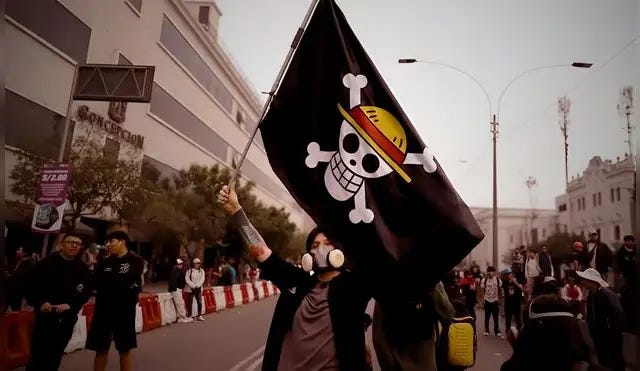

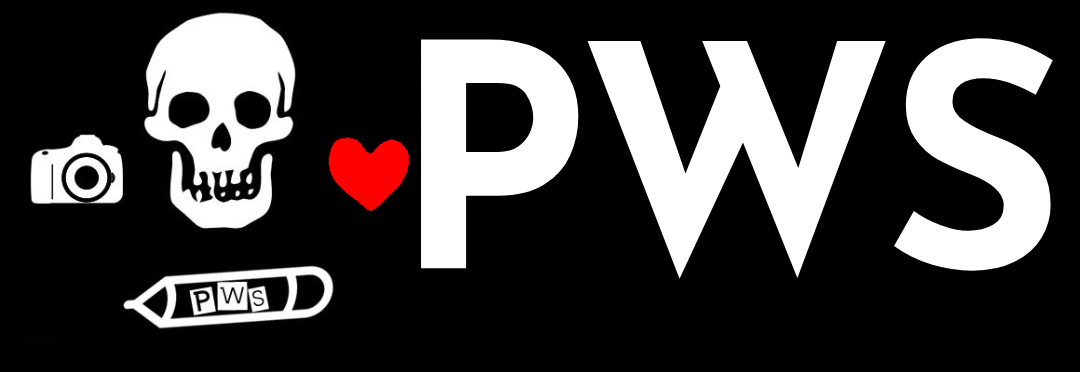
Wondering about the Lima/Peru journos you follow to get this info, or if you have someone(s) local based here. Thanks!
In my old job researching U.S. protest activity for academic and public-interest research, I saw the One Piece flag at a smattering of rallies and demos and such in 2023 and 2024. If I recall correctly, most or all of those were actions protesting the genocide in Gaza. I don't recall seeing it at all in the previous few years.